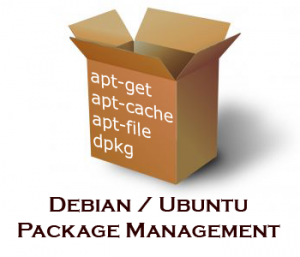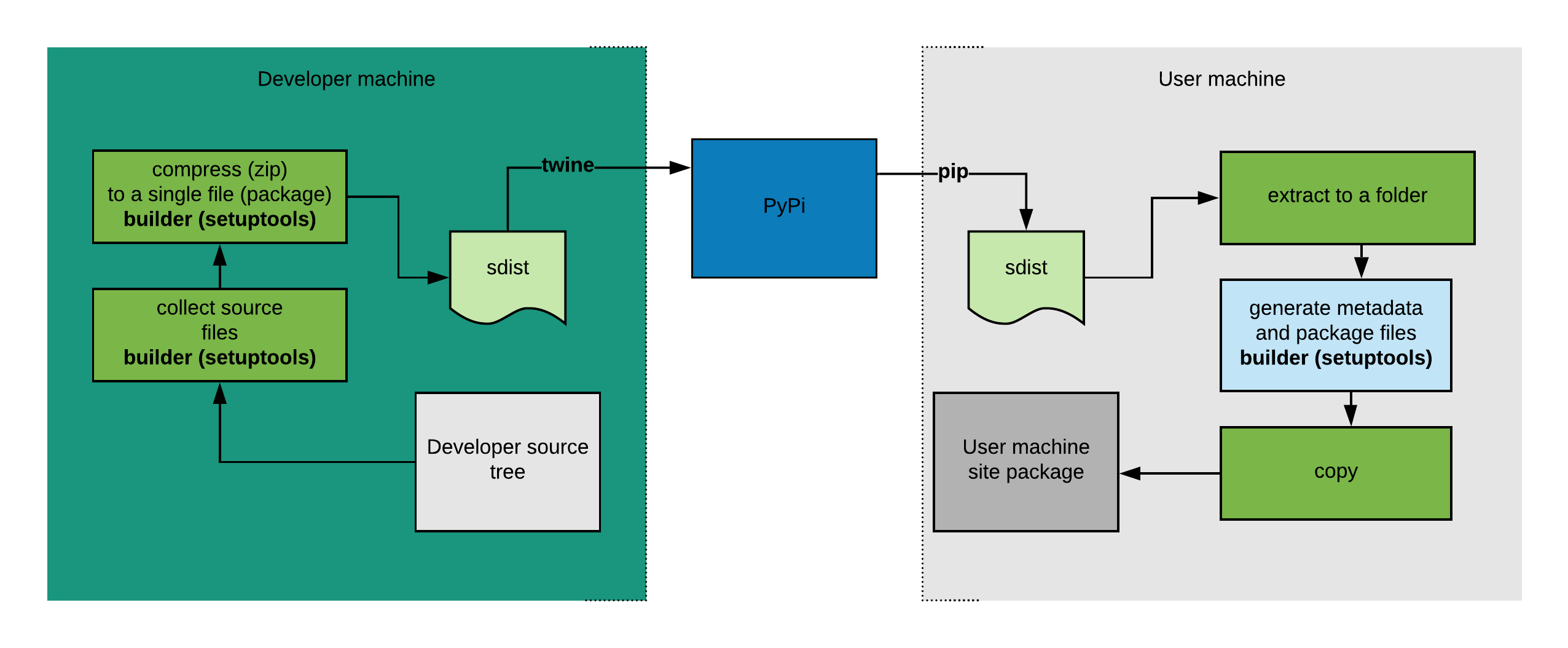How best to package your library?
by Bernat Gabor / @gjbernat / Bloombergbit.ly/py-package

Who am I?
- github/gaborbernat
- Maintainer of the virtualenv tool
- PyPa (Python Packaging Authority) member
- Maintainer of the tox tool
- Software Engineer at Bloomberg
The state of Python packaging
From PyPa point of view
so no tools such as


example project
pugs-project
├── README.rst
├── setup.cfg
├── setup.py
├── LICENSE.txt
├── src
│ └── pugs
│ ├── __init__.py
│ └── logic.py
├── tests
│ ├── test_init.py
│ └── test_logic.py
├── tox.ini
└── azure-pipelines.yml
- business logic
- test code
- packaging code
- project management and maintenance: CI/version control
example project
pugs-project
├── README.rst
├── setup.cfg
├── setup.py
├── LICENSE.txt
├── src
│ └── pugs
│ ├── __init__.py
│ └── logic.py
├── tests
│ ├── test_init.py
│ └── test_logic.py
├── tox.ini
└── azure-pipelines.yml
- business logic
- test code
- packaging code
- project management and maintenance: CI/version control
example project
pugs-project
├── README.rst
├── setup.cfg
├── setup.py
├── LICENSE.txt
├── src
│ └── pugs
│ ├── __init__.py
│ └── logic.py
├── tests
│ ├── test_init.py
│ └── test_logic.py
├── tox.ini
└── azure-pipelines.yml
- business logic
- test code
- packaging code
- project management and maintenance: CI/version control
example project
pugs-project
├── README.rst
├── setup.cfg
├── setup.py
├── LICENSE.txt
├── src
│ └── pugs
│ ├── __init__.py
│ └── logic.py
├── tests
│ ├── test_init.py
│ └── test_logic.py
├── tox.ini
└── azure-pipelines.yml
- business logic
- test code
- packaging code
- project management and maintenance: CI/version control
example project
pugs-project
├── README.rst
├── setup.cfg
├── setup.py
├── LICENSE.txt
├── src
│ └── pugs
│ ├── __init__.py
│ └── logic.py
├── tests
│ ├── test_init.py
│ └── test_logic.py
├── tox.ini
└── azure-pipelines.yml
- business logic
- test code
- packaging code
- project management and maintenance: CI/version control
What does it do?
Python 3.7.2 (v3.7.2:9a3ffc0492, Dec 24 2018, 02:44:43)
[Clang 6.0 (clang-600.0.57)] on darwin
Type "help", "copyright", "credits" or "license" for more information.
>>> import pugs
>>> pugs.do_tell()
"An enlightened pug knows how to make the best of whatever he has to work with - A Pug's Guide to Dating - Gemma Correll"

How to make this available on another machine?
>>> import pugs
>>> pugs
<module 'pugs' from '/Users/bernat/Library/Python/3.7/lib/python/site-packages/pugs/__init__.py'>
>>> import sys
>>> print('\n'.join(sys.path))
/Library/Frameworks/Python.framework/Versions/3.7/lib/python37.zip
/Library/Frameworks/Python.framework/Versions/3.7/lib/python3.7
/Library/Frameworks/Python.framework/Versions/3.7/lib/python3.7/lib-dynload
/Users/bernat/Library/Python/3.7/lib/python/site-packages
/Library/Frameworks/Python.framework/Versions/3.7/lib/python3.7/site-packages
High level package acquisition

Installed package structure
- package files
- package metadata: {package}-{version}.dist-info - PEP-427
/Users/bernat/Library/Python/3.7/lib/python/site-packages/pugs
├── __init__.py
├── __pycache__
│ ├── __init__.cpython-37.pyc
│ └── logic.cpython-37.pyc
└── logic.py
/Users/bernat/Library/Python/3.7/lib/python/site-packages/pugs-0.0.1.dist-info
├── INSTALLER
├── LICENSE.txt
├── METADATA
├── RECORD
├── WHEEL
├── top_level.txt
└── zip-safe
Installed package structure
- package files
- package metadata: {package}-{version}.dist-info - PEP-427
/Users/bernat/Library/Python/3.7/lib/python/site-packages/pugs
├── __init__.py
├── __pycache__
│ ├── __init__.cpython-37.pyc
│ └── logic.cpython-37.pyc
└── logic.py
/Users/bernat/Library/Python/3.7/lib/python/site-packages/pugs-0.0.1.dist-info
├── INSTALLER
├── LICENSE.txt
├── METADATA
├── RECORD
├── WHEEL
├── top_level.txt
└── zip-safe
Installed package structure
- package files
- package metadata: {package}-{version}.dist-info - PEP-427
/Users/bernat/Library/Python/3.7/lib/python/site-packages/pugs
├── __init__.py
├── __pycache__
│ ├── __init__.cpython-37.pyc
│ └── logic.cpython-37.pyc
└── logic.py
/Users/bernat/Library/Python/3.7/lib/python/site-packages/pugs-0.0.1.dist-info
├── INSTALLER
├── LICENSE.txt
├── METADATA
├── RECORD
├── WHEEL
├── top_level.txt
└── zip-safe
How to generate the packages?
- source distribution - sdist
- wheel distribution

What is a source distribution?
- source tree minus
- project management files
- maintainer files
- has business logic, packaging, tests
- all the files needed to install a package from raw source
What is a source distribution?
pugs-project
├── .git
├── README.rst
├── setup.cfg
├── setup.py
├── LICENSE.txt
├── src
│ └── pugs
│ ├── __init__.py
│ └── logic.py
├── tests
│ ├── test_init.py
│ └── test_logic.py
├── tox.ini
└── azure-pipelines.yml
What is a wheel?
- source tree minus
- project management files
- maintainer files
- tests
- packaging files
- the installed binary files with some meta data
What is a wheel?
pugs-project
├── .git
├── README.rst
├── setup.cfg
├── setup.py
├── LICENSE.txt
├── src
│ └── pugs
│ ├── __init__.py
│ └── logic.py
├── tests
│ ├── test_init.py
│ └── test_logic.py
├── tox.ini
└── azure-pipelines.yml
What is a wheel?
/Users/bernat/Library/Python/3.7/lib/python/site-packages/pugs
├── __init__.py
├── __pycache__
│ ├── __init__.cpython-37.pyc
│ └── logic.cpython-37.pyc
└── logic.py
/Users/bernat/Library/Python/3.7/lib/python/site-packages/pugs-0.0.1.dist-info
├── INSTALLER
├── LICENSE.txt
├── METADATA
├── RECORD
├── WHEEL
├── top_level.txt
└── zip-safe
How to ship a source distribution?
pugs-project
├── .git
├── README.rst
├── setup.cfg
├── setup.py
├── LICENSE.txt
├── src
│ └── pugs
│ ├── __init__.py
│ └── logic.py
├── tests
│ ├── test_init.py
│ └── test_logic.py
├── tox.ini
└── azure-pipelines.yml
How to ship a source distribution?

What is a wheel?
/Users/bernat/Library/Python/3.7/lib/python/site-packages/pugs
├── __init__.py
├── __pycache__
│ ├── __init__.cpython-37.pyc
│ └── logic.cpython-37.pyc
└── logic.py
/Users/bernat/Library/Python/3.7/lib/python/site-packages/pugs-0.0.1.dist-info
├── INSTALLER
├── LICENSE.txt
├── METADATA
├── RECORD
├── WHEEL
├── top_level.txt
└── zip-safe
How to ship a wheel?
pugs-project
├── .git
├── README.rst
├── setup.cfg
├── setup.py
├── LICENSE.txt
├── src
│ └── pugs
│ ├── __init__.py
│ └── logic.py
├── tests
│ ├── test_init.py
│ └── test_logic.py
├── tox.ini
└── azure-pipelines.yml
What is a wheel?
/Users/bernat/Library/Python/3.7/lib/python/site-packages/pugs
├── __init__.py
├── __pycache__
│ ├── __init__.cpython-37.pyc
│ └── logic.cpython-37.pyc
└── logic.py
/Users/bernat/Library/Python/3.7/lib/python/site-packages/pugs-0.0.1.dist-info
├── INSTALLER
├── LICENSE.txt
├── METADATA
├── RECORD
├── WHEEL
├── top_level.txt
└── zip-safe
wheel

generate wheel - PEP 427
- select and copy python files
- generate metadata - PEP 376
- generate pyc files
- generate binary library if c-extension package (C/CPP files)
- get C/C++ toolchain (compiler, dependencies, libraries, etc)
- compress it into a file named PEP 425
psutil-5.6.2-cp37-cp37m-win_amd64.whl
generate wheel - PEP 427
- select and copy python files - requires correct setuptools version
- generate metadata - PEP 376 - requires correct wheels version
- generate pyc files - requires correct python version
- generate binary library if c-extension package (C/CPP files)
- get C/C++ toolchain (compiler, dependencies, libraries, etc)
- compress it into a file named PEP 425 - requires correct wheels version
psutil-5.6.2-cp37-cp37m-win_amd64.whl
Why?
if version 41.0.0 setuptools adds collect_magic_files
from setuptools import setup
setup(collect_magic_files=True)
running with version 40.0.0 will not work
buckle up for a bit of history

History of packaging
- 2000 - Python 1.6 - distutils - setup.py introduced
- 2004 - setuptools - quickly became de facto standard
- 2008 - pip (replaces easy_install)
- 2014 - wheels
- setuptools/wheels - setup.py arbitrary user code
- 2015 - flit - declarative over dynamic (arbitrary code run)
- easier to understand
- harder to get wrong
How does a build work? - sdist - developer machine
- on the source tree invoke the command
python setup.py sdist - upload to pypi
python setup.py upload # http connection - post
How does a build work? - sdist - developer machine
- on the source tree invoke the command
python setup.py sdist - upload to pypi
python setup.py upload # http connection - post
How does a build work? - sdist - developer machine
- on the source tree invoke the command
python setup.py sdist - upload to pypi
twine upload package-sdist.targ.gz # https connection - post - guaranteed
How does a build work? - sdist - user machine
pip install pugs==1.0.0
python setup.py install
Problem 1 - build dependencies
-
setuptools pulled in from the builder python
python setup.py sdist python setup.py install -
cryptic error if build dependencies are missing
File "setup_build.py", line 99, in run from Cython.Build import cythonize ImportError: No module named Cython.Build - or even worse no error - incorrect version
- or even worse - user can hijack setuptools and try to inject their own code
Problem 1 - build dependencies
Idea: declarative build environment provision
python setup.py install
- create temporary folder
- create an isolated python environment
python -m virtualenv our_build_env - install build dependencies
our_build_env/bin/python -m pip dep1 dep2 - generate a wheel, that we can simply install afterwards
our_build_env/bin/python setup.py bdist_wheel
Problem 1 - build dependencies
- PEP-518
- specify deps via pyproject.toml
[build-system] requires = [ "setuptools >= 40.8.0", "wheel >= 0.30.0", "cython >= 0.29.4", ] - TOML - Tom's Obvious, Minimal Language.
- standardized
- not overly complex
- does not conflict with other files out there - setup.cfg
Problem 1 - build dependencies
- PEP-518
- build backend - performs the package generation in an isolated environment
- setuptools
- flit
- poetry
-
build frontend - prepares the isolated environment, and invokes the backend
- pip - PEP-518 support with version 18.0
- tox - PEP-518 support with version 3.3.0
- poetry
yay

Problem 2 - diversity - better user interface
- PEP-518 involves still calling to setup.py
our_build_env/bin/python setup.py bdist_wheel - setup.py allows arbitrary python code to run - cannot change due to backward compatibility
- flit implementation still involves generating setup.py and adhering to those limitations
Problem 2 - diversity - better user interface
- PEP-517
- So instead of:
our_build_env/bin/python setup.py bdist_wheel - Allow build backends to expose invocation end-points:
[build-system] requires = ["flit"] build-backend = "flit.api:main" - And the build frontend will now do:
import flit.api backend = flit.api.main backend.build_wheel() # build wheel via backend.build_sdist() # build source distribution via
Problem 2 - diversity - better user interface
- PEP-517
- So instead of:
our_build_env/bin/python setup.py bdist_wheel - Allow build backends to expose invocation end-points:
[build-system] requires = ["flit"] build-backend = "flit.api:main" - And the build frontend will now do:
import flit.api backend = flit.api.main backend.build_wheel() # build wheel via backend.build_sdist() # build source distribution via
Problem 2 - diversity - better user interface
- PEP-517
- So instead of:
our_build_env/bin/python setup.py bdist_wheel - Allow build backends to expose invocation end-points:
[build-system] requires = ["flit"] build-backend = "flit.api:main" - And the build frontend will now do:
import flit.api backend = flit.api.main backend.build_wheel() # build wheel via backend.build_sdist() # build source distribution via
Problem 2 - diversity - better user interface
Caveats
- No editable install support yet
- requires fairly new pip
- on developer machine - if wheel distribution
- on user machine - if source distribution
Build dependencies - developer machine
- pip build command planned, for now pep517 package
- to build a wheel going forward use the following command:
python -m pep517.build --binary --out-dir /tmp/build-to . # old -> python setup.py bdist_wheel - to build a sdist going forward use the following command:
python -m pep517.build --source --out-dir /tmp/build-to . # old -> python setup.py sdist
Benefits
- Reproducible declarative builds
- No more need for setup.py
- simpler packaging that fails less often
tox

tox
- Not implicitly activated (version 4 probably will have it)
- add
[tox] isolated_build = True - during the packaging phase the source distribution will be built inside an isolated env
- RIP
python setup.py sdist
summary
- PEP-518 - ensures declarative and reproducible build environments
- PEP-517 - ensures we no longer build on top of old/legacy setup.py infrastructure

Summary
- check-out the new ways to package your code
- setuptools - general purpose (c-extensions) - now provides setup.cfg only
- flit - simple pure python apps - pyproject.toml config
- poetry - one tool to rule them all - pyproject.toml config
- to build a wheel:
python -m pep517.build --binary --out-dir /tmp/build-to . - to build a sdist:
python -m pep517.build --source --out-dir /tmp/build-to .
thank you
https://www.bernat.tech/pep-517-and-python-packaging/
